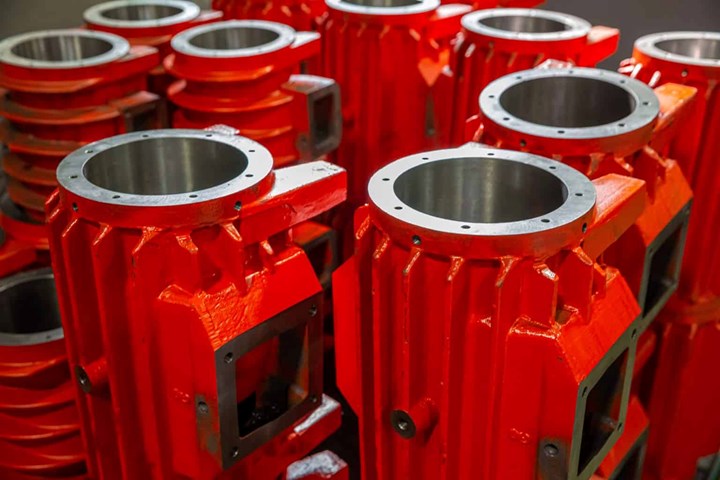Choosing Paint for Fast-Paced, Extra Slip, High Temp Applications
Many industrial applications require coatings that not only offer corrosion resistance and aesthetics, but provide additional attributes such as heat resistance and quick drying properties. This helpful clinic offers a few examples.

Fast-paced manufacturing applications require quick-drying coating solutions — coatings designed for force-dry applications can reduce the risk of parts sticking together. Source: Cortec Corp.
Q: What coatings are recommended for meeting force-dry, high slip or high temp requirements?
A: In addition to good adhesion and rust prevention, a metal coating must be equipped to meet force-dry, high slip, or high temp requirements in certain applications. While it would be difficult to list all of the industrial applications where force-dry, extra slip or high temp coatings could be used, here are a few examples of where such solutions are needed.
Force-dry applications
Fast-paced manufacturing applications require quick-drying coating solutions. Many spray or dip lines move so quickly that the parts pile up at the end of the line. This is bad news if parts are hot and sticky — they could easily adhere to each other and potentially damage the coating when components are pulled apart.
EcoShield 386 FD, which is designed for force-dry applications, reduces the risk of parts sticking together. While this water-based acrylic one coat system can be applied direct-to-metal (DTM) for protection in harsh, outdoor or unsheltered applications, it was specifically designed for fast-paced, force-dry applications, common in manufacturing environments. In addition to outstanding corrosion protection at 1.5-3.0 mils (37.5-75 µm) DFT (dry film thickness), EcoShield 386 FD force-dries in just 5-10 minutes at 150°F (65°C) and has good hot hardness.
This feature can offer an advantage in manufacturing applications where pipes, hooks, castings, and a variety of other equipment components are made.
Extra slip applications
A protective ID (inner diameter) coating can be critical for new piping stored outdoors or shipped through harsh, corrosive conditions. However, when it comes time to install the conduits, electrical wires must be able to slide easily through the tubing. Electrical conduits are a good example of where a slip coating such as EcoShield VpCI-386 HT can be beneficial. The direct-to-metal, water-based topcoat helps allow the wires to move through the tubing while also inhibiting corrosion.
EcoShield VpCI-386 offers excellent corrosion protection at 1.5-2.0 mils (37.5-50.0 µm) DFT. It is heat resistant up to 500°F (260°C) or more (depending on color) and improves surface slip. The coating is thixotropic and resists sagging and running during application.
The same benefits would apply to other metal surfaces, parts, or equipment in need of a protective coating that is slippery.
High temp applications
In addition to needing extra slip, electrical conduits are a great example (although by no means the only example) of a high temp application. These pipes start out as flat pieces of metal that are rolled into tubes, welded and internally painted before the welding heat can cool down. EcoShield VpCI-386 HT Slip Coating is designed to withstand this extra heat during coating application and similar high heat curing processes. It can also be used on equipment that may reach temperatures up to 500°F (260°C) during operation.
Anticorrosion coatings with additional features
While the main purpose of a coating may be to protect metals from corrosion, many manufacturing applications may introduce additional special requirements, such as force drying, extra slip or high temperature resistance. Make sure to weigh all considerations when selecting a coating to stand up to these demanding applications.
*Special thanks to subject matter expert Rick Shannon for technical support on this topic.
About the Author

Julie Holmquist
Julie Holmquist is a content writer for Cortec Corporation. Visit corteccoating.com.
Related Content
Products Finishing Reveals 2024 Qualifying Top Shops
PF reveals the qualifying shops in its annual Top Shops Benchmarking Survey — a program designed to offer shops insights into their overall performance in the industry.
Read MoreRobots, AI and Superb BMW Surfaces
There isn’t an automotive paint shop in the world that doesn’t have post-paint inspection and defect processing. But BMW is doing this with levels of technology at a plant in Germany that exceed all other paint shops in the world.
Read MoreHenry Ford Is Still Right When It Comes to Color
Who would have imagined that more than 100 years after his famous statement about any color as long as it’s black would still have relevance of a sort?
Read MoreIntumescent Coating Provides Up to 3 Hours of Fire Protection
PPG Steelguard 951 coating is designed to provide protection against fire and corrosion.
Read MoreRead Next
Pretreatment for Painting
Better adhesion, enhanced corrosion and blister resistance, and reduced coating-part interactions make pretreatment a must.
Read MoreCuring Oven Basics
Simply heating up the substrate does not cure the coating. There are many variables to consider when choosing the best cure oven for your application...
Read MoreA ‘Clean’ Agenda Offers Unique Presentations in Chicago
The 2024 Parts Cleaning Conference, co-located with the International Manufacturing Technology Show, includes presentations by several speakers who are new to the conference and topics that have not been covered in past editions of this event.
Read More












.jpg;maxWidth=300;quality=90)








